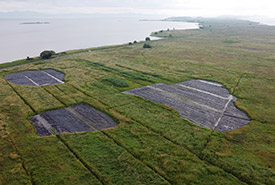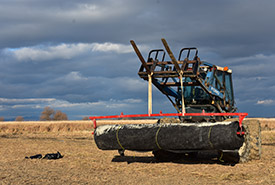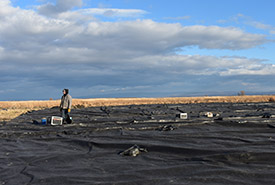A hostile species in an exceptional habitat

Tarps covering phragmites colonies in the upper marshes of Île aux Grues (Photo by DanielTphoto)
Marshes and other wetlands have long been misunderstood. Often seen as unattractive, these areas are in fact extremely rich in biodiversity and function. In addition to providing quality habitat, they play a variety of important ecological roles, such as replenishing and purifying groundwater, and preventing flooding and drought. They also help protect riverbanks from storms and store a large amount of carbon. For all of these reasons, the Nature Conservancy of Canada (NCC) is stepping up efforts to protect wetlands across the province, including on Île aux Grues.
The upper marshes on Île aux Grues
Located in the heart of the St. Lawrence River, Île aux Grues lies about 80 kilometres east of Quebec City. It is recognized as a high biodiversity site in Quebec — over 200 bird species nest or stop to refuel here during migration. Île aux Grues is connected to the neighbouring Île aux Oies by a tidal flat known as the upper marshes.

The team installs the tarps with the help of a tractor (Photo by NCC)
The many bird species that frequent the area include bobolink (an at-risk species in Canada), Nelson’s sharp-tailed sparrow (a species likely to be designated at-risk or vulnerable in Quebec), short-eared owl (a species of special concern in Canada and likely to be designated at-risk or vulnerable in Quebec) and yellow rail (a species of special concern in Canada and at-risk in Quebec). The upper marshes are also the preferred hunting grounds for many birds of prey, including peregrine falcon. They have been designated a waterfowl gathering area under the Quebec government’s Regulation respecting wildlife habitats. NCC protects 170 hectares on Île aux Grues, including the Jean-Paul-Riopelle Nature Reserve at Pointe aux Pins. Even though this land is protected, it is still vulnerable to certain threats. There is a marked presence of phragmites, an invasive species, in the upper marshes. Also known as common reed, this plant, which was introduced from Europe and Asia, degrades the quality of wetlands by depriving wildlife of their habitats and driving out native plant species. Phragmites harms biodiversity in the areas it colonizes by rapidly out-crowding other species, preventing them from growing.
A colossal task
NCC has known about the presence of phragmites in the upper marshes for several years and first surveyed its spread in 2014. Follow-up studies since have confirmed our worst fears: the species is gaining ground every year.

It was essential to take action, because this formidable invader was posing a threat to numerous local plant and animal species. Given the fragile nature of the area, we had limited options when it came to invasive plant species control and eradication methods, so we had to be inventive. We also had to take into account the effect of the tides and freezing temperatures on the site. After an initial series of trials carried out between 2015 and 2017 on the upper marsh properties, and in light of results obtained by other property owners trying to limit the damage caused by this invasive species, in 2019, NCC launched a wide-scale project aimed at controlling phragmites in this area.
Why did we choose these methods?
Tarping:
Once geotextile tarps are firmly anchored in the ground, they prevent sunlight from reaching the invasive plants. Deprived of this essential energy source, the plants slowly use up their resources and die after a few years.Mowing:
Repeated mowing has a similar, albeit less dramatic, effect as tarping. When the plants are mowed several times a year over a period of several years, they require more energy to grow than they are able to produce and are, as a result, unable to complete their annual life cycle (seed production). Eventually, the plants’ growth is slowed and they become less and less robust. Combined with other techniques, mowing slows down the spread of established colonies.
We first inventoried the phragmites colonies in the upper marshes to get an overview of the situation. We conducted rigorous studies and drew up a detailed plan for eradication. Given the environment of the upper marshes, the use of chemical control methods like herbicides is prohibited. We therefore opted for mowing and tarping, even though these solutions are relatively complex to implement.
The first stage of this project was completed in the fall of 2020. We applied both tarping and mowing to maximize our chances of success. We used local expertise as much as possible by forming partnerships with companies and suppliers in the region — an effective way to foster ties with the community! After mowing all of the targeted colonies, we and our partners covered all the surfaces with large tarps, which will be left in place for several years. It was a major job for our dedicated team!
Challenges and victories

A team member examines a tarp (Photo by NCC)
This project is not without its challenges. Because of flooding caused by the river’s high tides, the upper marshes are only accessible for limited periods of time. Given the fragility of this ecosystem, the team had to take measures to minimize the impact of machinery on nesting birds and the ground. That’s why we chose the fall as the ideal period to complete the work. But the team faced additional challenges such as wind and freezing temperatures, which made it trickier to install the immense tarps. Fall is also hunting season for migratory birds, which is a very popular activity in the region.
This tireless work was carried out over two years, covering a total surface of two hectares. Once the installation is complete, monitoring and regular maintenance are planned for the coming years. We also mowed two hectares of colonies, for a control project totalling four hectares. When we remove the tarps in 2025, we’ll revegetate the area with native species to restore the upper marshes’ rich biodiversity.
A widespread battle
NCC controls phragmites elsewhere in Canada using a variety of methods. In Ontario, a special phragmites control project in partnership with the Ministry of Natural Resources and Forestry uses chemical herbicides. In some cases, the reed is so abundant that its impact on the ecosystem justifies the use of such measures. Read more about NCC’s fight in Ontario, and watch this video to learn how to identify invasive phragmites and how to control it manually!
Participating partners








This project benefitted from funds provided by the Government of Canada through the Habitat Stewardship Program and the Priority Places program, part of Canada’s Nature Fund, as well as funds provided by the Quebec Government to Fondation de la faune du Québec for its Program for the battle against invasive exotic plants and to NCC’s Projet de partenariat pour les milieux naturels, for which NCC received more than $53M in support from the Quebec government.




